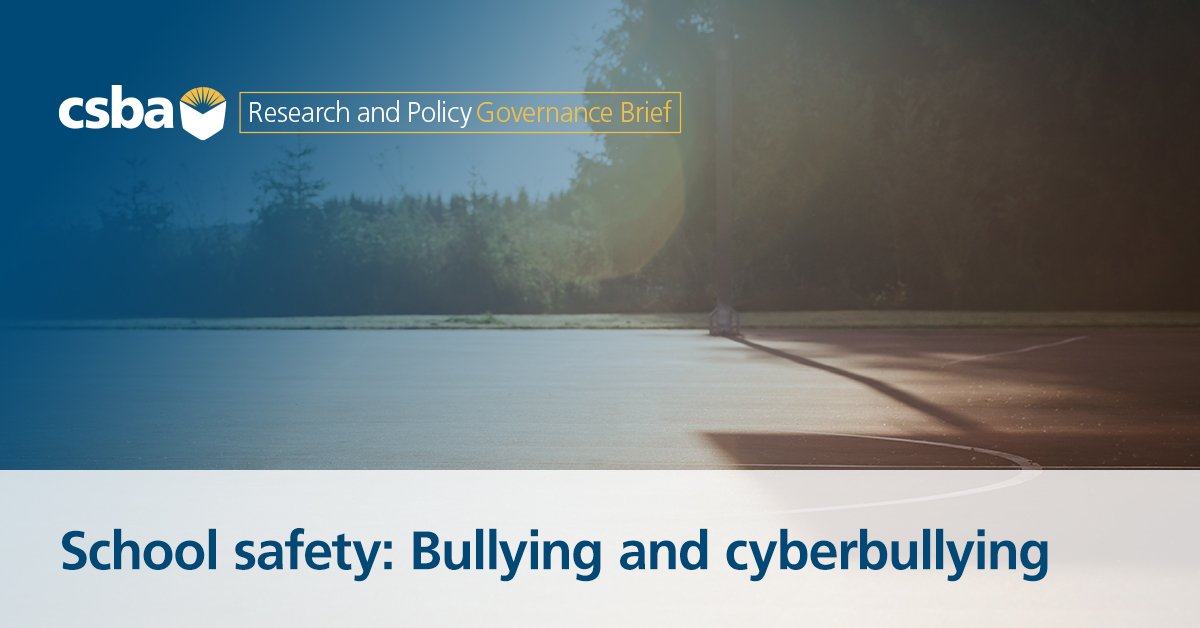October is National Bullying Prevention Month and local educational agencies should consider how they can foster positive, safe and inclusive school environments in order to prevent bullying and boost student success.
CSBA’s Research and Education Policy Development (REPD) Department has published a governance brief, “School safety: Bullying and cyberbullying,” that includes definitions and statistics on bullying and cyberbullying, information on the impacts of bullying and signs that someone is being bullied, how LEAs can help students and families, examples of bullying prevention communications , sample questions for board members and other resources.
“This new brief is in addition to our suite of resources on school safety and updates our previous Bullying Fact Sheet while adding the very real threat of cyberbullying to the conversation,” said REPD Principal Research Manager Angela Asch, the brief’s author. “LEAs are encouraged to read the brief and use it to strengthen their policies, practices and community partnerships to reduce bullying and cyberbullying.”
Further, under Assembly Bill 2291, the Safe Place to Learn Act adopted in 2018, LEAs are required to adopt bullying prevention policies and practices.
In the aftermath of the pandemic, Asch said that CSBA members are concerned about students’ struggles with mental health. Incorporating anti-bullying measures can support mental health and wellness and boost academic achievement.
About bullying
Bullying, defined by the U.S. Department of Health and Human Services as “unwanted, aggressive behavior that involves a real or perceived power imbalance. The behavior is repeated, or has the potential to be repeated, over time,” and is considered an adverse childhood experience.
It takes on many forms including verbal, social/relational, physical and cyberbullying.
According to the Centers for Disease Control and Prevention, in 2021, one in five teens experienced bullying in school and one in six experienced cyberbullying. Groups that experienced the highest rates of bullying included LGBTQ youth, females and white students (in comparison to their Hispanic and Black peers).
And bullying doesn’t just happen among older students. Thirteen percent of elementary-aged students said they experienced cyberbullying and 43 percent reported experiencing verbal harassment/bullying in school, according to 2019–21 data from the California Healthy Kids Survey.
Impacts
Negative academic outcomes are a potential result of bullying as is an increased likelihood of self-harm behaviors for those who are victimized — even after their time in the K-12 system.
Though bullying can be hard to detect, educators and families can look for symptoms displayed by their student or child such as withdrawing from friends and family; not wanting to attend school; declining grades; talk of feeling sad, nervous, anxious or angry; trouble sleeping; and/or no longer showing interest in their favorite activities.
Bullying can lead to lasting emotional, psychological and educational harm to victims, but also to perpetrators, with research indicating that individuals who bully others are more likely to suffer academically in school, abuse drugs and alcohol as they get older, and be more prone to committing subsequent violence or experience more acts of violence. “The school’s approach to working with students who bully can be important to preventing future issues for the students themselves and their peers,” the brief states.
Asch said while it may feel counterintuitive, addressing what is underlying the bully’s behavior is key to preventing future incidents. “It may not be the first thought to educate and support the student that enacted the bullying behavior; but it is equally important to provide resources and services to that individual or individuals to stop the behavior from happening in the future,” she said. “Pushing students out for negative behaviors may have unintended consequences in the future. Educating and supporting students and reminding them of positive behavior expectations is key to changing students’ behaviors and the school environment.
“When left unchecked, bullying behavior negatively impacts school climate and hurts all individuals involved, even those that witnessed the behavior as bystanders,” Asch continued. “Negative behavior that is allowed to occur and continue sends the implicit message that that behavior is acceptable, and that school is not a safe place.”
Open, consistent communication with students regarding the importance of identifying and mitigating bullying is encouraged to improve school climate and safety.
Resources
LEAs can implement proven bullying prevention methods such as utilizing diverse, communitywide resources; implementing clear schoolwide expectations; providing training for all staff, enacting Multi-Tiered Systems of Supports; addressing multiple components of bullying behavior and the environments that foster it; including student voice in the creation and implementation of bullying prevention programs; including mentorship for students; strengthening peer-to-peer relationships; and teaching inter- and intrapersonal skills.
Asch offered examples of LEAs’ bullying prevention communications:
“Santa Clara County Office of Education, mentioned in the brief, provides information in English and Spanish on their website, making it accessible to a wider audience. Knowing what your community needs is important to providing accessible and applicable information,” Asch said. “Anonymous reporting systems, like STOPit used by Garden Grove Unified, and similar systems used by other LEAs are a useful tool to implement. Social and emotional learning is also important to implement at every grade level.”
Guiding questions for board members to consider are included in the brief. Also detailed are relevant CSBA sample policies, administrative regulations and legal guidance to support LEAs along with resources from state and federal agencies and other expert organizations.
Read the brief here.





